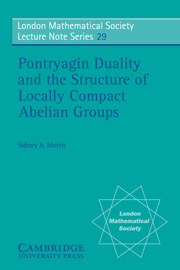Book contents
- Frontmatter
- Contents
- Preface
- 1 Introduction to topological groups
- 2 Subgroups and quotient groups of Rn
- 3 Uniform spaces and dual groups
- 4 Introduction to the Pontryagin-van Kampen duality theorem
- 5 Duality for compact and discrete groups
- 6 The duality theorem and the principal structure theorem
- 7 Consequences of the duality theorem
- 8 Locally Euclidean and NSS-groups
- 9 Non-abelian groups
- References
- Index of terms
- Index of Exercises, propositions and theorems
6 - The duality theorem and the principal structure theorem
Published online by Cambridge University Press: 11 November 2009
- Frontmatter
- Contents
- Preface
- 1 Introduction to topological groups
- 2 Subgroups and quotient groups of Rn
- 3 Uniform spaces and dual groups
- 4 Introduction to the Pontryagin-van Kampen duality theorem
- 5 Duality for compact and discrete groups
- 6 The duality theorem and the principal structure theorem
- 7 Consequences of the duality theorem
- 8 Locally Euclidean and NSS-groups
- 9 Non-abelian groups
- References
- Index of terms
- Index of Exercises, propositions and theorems
Summary
In Chapter 5 we proved the duality theorem for compact groups and discrete groups. To extend the duality theorem to all LCA-groups we will prove two special cases of the following proposition: If G is an LCA-group with a subgroup H such that both H and G/H satisfy the duality theorem, then G satisfies the duality theorem. The two cases we prove are when H is compact and when H is open. The duality theorem for all LCA-groups then follows from the fact that every LCA-group G has an open subgroup H which in turn has a compact subgroup K such that H/K is an “elementary group” which is known to satisfy the duality theorem. By an “elementary group” we mean one which is of the form Ra × Zb × Tc × F, where F is a finite discrete abelian group and a, b and c are non-negative integers. Once we have the duality theorem we use it, together with the above structural result, to prove the Principal Structure Theorem.
We begin with some structure theory.
Definition. A topological group is said to be monothetic if it has a dense cyclic subgroup.
Examples. Z and T are monothetic.
Theorem 19. Let G be a monothetic LCA-group. Then either G is compact or G is topologically isomorphic to Z.
Proof. If G is discrete then either G = Z or G is a finite cyclic group and hence is compact. So we have to prove that G is compact if it is not discrete.
- Type
- Chapter
- Information
- Publisher: Cambridge University PressPrint publication year: 1977



